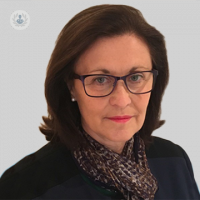Minimally invasive spine surgery: advantages and preparation
Escrito por:In minimally invasive surgery, doctors use a variety of methods to operate with less damage to the body than with traditional open surgery.

We spoke to an extremely experienced neurosurgeon, Mrs Anne Mitchener, to find out about non-invasive spine surgery specifically. We learnt about the main conditions this surgery treats, as well as what happens during and after the MIS for the spine.
Why might I need non-invasive spine surgery?
The symptoms that should be addressed would be spinal pain, including neck and lower back and referred pain or weakness in any limb. Whether somebody needs minimally invasive surgery (MIS) or whether they choose to have that is a bit different.
We endeavour to carry out MIS if the patient is relatively frail or has other conditions. We want to manipulate the tissues as little as possible. It isn’t necessarily very often but wanting MIS is more common and we would support that when it’s possible to do that as there is usually less post-operative pain and a quicker recovery.
Which conditions of the back can be treated with non-invasive spine surgery?
So disc herniation can be treated and indeed is usually treated minimally invasively. Minimally invasive means a small incision in the skin and the use of a microscope but these days can include endoscopic spinal discectomy, where there is usually even smaller incisions, but not may surgeons offer this.
Neck and particularly back pain, low back pain, can also be treated minimally invasively with a fusion procedure. Likewise spinal instability can be treated minimally invasively with a fusion procedure the instability having arisen through degeneration of osteoporosis or trauma or tumours.
What are the advantages of minimally invasive spine surgery?
Advantages include:
- Better cosmetic results from the smaller incision.
- Less blood loss.
- Reduced muscle damage
- Reduced risk of infection and post-operative pain.
- Faster recovery from surgery.
- Less reliance on pain medication after surgery.
How can I prepare for the surgery?
As preparation for any surgery, if possible, smokers would stop smoking, before the surgery if they can. Anyone who is overweight, would reduce their weight as best they can, making arrangements for post-operative recovery whether that’s at work or at home or with children.
What happens during minimally invasive spine surgery?
Some MIS especially for disc hernaiation, make use of a microscope or possibly, operating loops, which are two small microscopes worn on glasses. Alternatively MIS where there is instrumentation usually involving placement of screws and in some place cages rely on specially engineered access which with a series of narrow introducer devices permit insertion of instruments and metal work for the spine.
A lot of work is undertaken down metal tubes called operating channels. Cages are placed between vertebrae, or less commonly, to replace vertebrae. These can be made of a special plastic PEEK (Polyether ether ketone) or of titanium and we usually pack them with some of the patients own bone or synthetic bone graft.
What happens after the procedure?
Usually the hospital stay is reduced with MIS mainly because the post-operative pain is much less. We would of course schedule a follow up appointment.
To find out if minimally invasive spine surgery is right for you, you may like to book an appointment with a leading neurosurgeon such as Mrs Anne Mitchener . Visit her Top Doctors profile today for more information.


